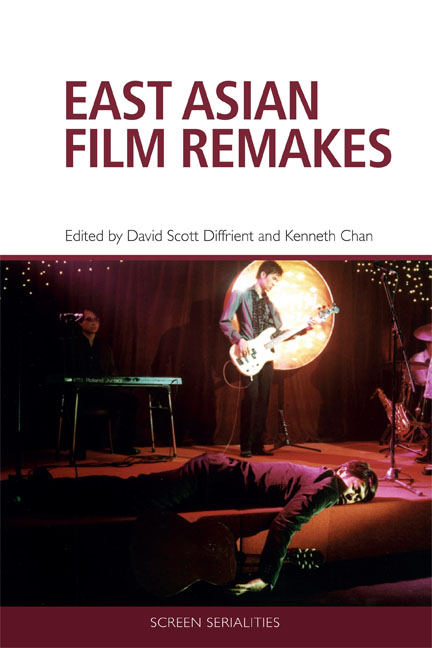Book contents
- Frontmatter
- Contents
- List of Illustrations
- Foreword
- Notes on Contributors
- Introduction: East Asian Film Remakes
- Part I Re-fleshing the Text: Sex, Seduction, Desire
- Part II Serialising Ozu: The Enduring Legacy of a Cinematic ‘Tofu Maker’
- Part III Revisiting Personal/Political Traumas in East Asian Action Films, Gangster Films and Westerns
- Part IV Local Flavours and Transcultural Flows in East Asian Comedies, Dramas and Fantasies
- Index
5 - Definition and Progression: Ozu Yasujirō’s ‘Noriko Trilogy’
Published online by Cambridge University Press: 01 March 2025
- Frontmatter
- Contents
- List of Illustrations
- Foreword
- Notes on Contributors
- Introduction: East Asian Film Remakes
- Part I Re-fleshing the Text: Sex, Seduction, Desire
- Part II Serialising Ozu: The Enduring Legacy of a Cinematic ‘Tofu Maker’
- Part III Revisiting Personal/Political Traumas in East Asian Action Films, Gangster Films and Westerns
- Part IV Local Flavours and Transcultural Flows in East Asian Comedies, Dramas and Fantasies
- Index
Summary
In his influential discussion of ‘the Noriko Trilogy’, a sequence of post-war films directed by Ozu Yasujirō and starring Hara Setsuko as the trilogy's eponymous female lead, Robin Wood argues that what unites the otherwise loose affiliation of Late Spring (Banshun, 1949), Early Summer (Bakushū, 1951) and Tokyo Story (Tōkyō monogatari, 1953) is the notion of any ‘resistance to definition’ (1998, 94). For Wood, the idea of ‘definition’ refers uniquely to the issue of the films’ complex projection of Noriko's subjectivity and the articulation of female desire within a generic structure that ultimately denies her full agency. This chapter pursues the matter of Ozu's projection of feminine agency across the three films, but also returns to a more foundational question concerning ‘definition’. What does it mean precisely to define these films retrospectively as a ‘trilogy’? What are the aesthetic and political consequences of considering this set of films in sole relation to the recurring name of a character played by their central female star? Is it possible to read the films in relation to each other in other mutually informing ways that continue to be critically meaningful in the context of recent scholarship on the politics of film trilogies? By opening up these issues, especially in relation to the subject of mobility on both a textual and contextual level, this chapter thus aims to shed new light on the complex ways in which Ozu's interest in pattern, repetition and difference operated at this transitional moment in popular Japanese cinema.
Of course, the very notion of a screen trilogy is in itself a mobile concept and, to this extent, Wood's definition of a screen trilogy, at least to some degree, matches one of the variations proposed by Claire Perkins and Constantine Verevis in their foundational work on the topic. Perkins and Verevis's notion of ‘authorial remaking’ argues for a specific form of attention ‘to the repetition of themes, settings, styles, characters, and actors’ that may occur across a set of three films directed by a single director in ways that can be said to typically constitute an ‘authorial vision’ (2012, 12). Ozu's work fits the bill on a number of levels, not least because his singular filmmaking method involves such a visibly recognisable set of distinctive stylistic attributes that his mode of looking is visible in every single frame of the films in question.
- Type
- Chapter
- Information
- East Asian Film Remakes , pp. 111 - 123Publisher: Edinburgh University PressPrint publication year: 2023

